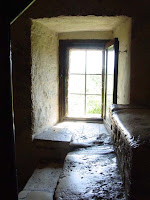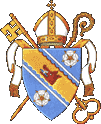Old School Pilgrimages
 Santa Chiara Basilica in Assisi, Italy
Santa Chiara Basilica in Assisi, ItalyOur recent trip to Italy and France was something of a pilgrimage. An important part of the trip was an opportunity to spend time in and around the Umbrian city of Assisi. My wife, Victoria, is a novice in the Third Order Society of Saint Francis, which is a lay order for married persons created in his Francis' lifetime. Both of us wanted a chance to see the sites related to the lives of both Francis and Clare.
 At times, the sort of pilgrimage industry got in the way of that desire. This is not so much the modern intrusion of tour buses full of folks going from one famous site to another. The problem was the more ancient tourist industry that led to the creation of the basilica of San Francesco (as Francis is known in his own language) at one end of town, with the basilica of Santa Chiara (as Clare is known) at the other end of Assisi. In between is the church built on the site of Francis' boyhood home, and up the hill is their childhood church and just down the hill is the church significant in both of their lives, San Damiano.
At times, the sort of pilgrimage industry got in the way of that desire. This is not so much the modern intrusion of tour buses full of folks going from one famous site to another. The problem was the more ancient tourist industry that led to the creation of the basilica of San Francesco (as Francis is known in his own language) at one end of town, with the basilica of Santa Chiara (as Clare is known) at the other end of Assisi. In between is the church built on the site of Francis' boyhood home, and up the hill is their childhood church and just down the hill is the church significant in both of their lives, San Damiano. The middle ages desire to build up shrines to the saints covered over the sites of the saints centuries ago. They left odd little vestiges here and there which we enjoyed, such as the olive grove on the hill between Assisi and San Damiano and the caves over the town on Mount Sabasio, both of which were the sorts of places Francis loved. The Francis statue pictured above with a dove in a basket in front, sports a live dove seemingly magically attached to the statue. The statue is at the church of St. Mary of the Angels.
 In addition to the pilgrimage places for Francis and Clare, we ran across many lesser known pilgrim sites, such as the time we stumbled into a church in Rome to find the bones of Saint Philip Neri being glass encased under the altar in front of us. There were lots of other saints encased in glass under altars or entombed under altars.
In addition to the pilgrimage places for Francis and Clare, we ran across many lesser known pilgrim sites, such as the time we stumbled into a church in Rome to find the bones of Saint Philip Neri being glass encased under the altar in front of us. There were lots of other saints encased in glass under altars or entombed under altars.In Todi, Italy, the Umbrian hill town where we lived for a week, San Fortunato Church was close by.
 Though not as large as the nearby Cathedral of Todi, San Fortunato was still impressive in scale by Camden County perspectives. Victoria and I enjoyed the feel of this church as much as any we visited. It was lovingly cared for with each side altar adorned with simple fresh flowers placed by the woman who kept bustling about cleaning and generally caring for the church. Built from 1292-1458, with a still unfinsihed facade, the church boasts the bodies of three saints and the hand and arm of its own patron saint, San Fortunato.
Though not as large as the nearby Cathedral of Todi, San Fortunato was still impressive in scale by Camden County perspectives. Victoria and I enjoyed the feel of this church as much as any we visited. It was lovingly cared for with each side altar adorned with simple fresh flowers placed by the woman who kept bustling about cleaning and generally caring for the church. Built from 1292-1458, with a still unfinsihed facade, the church boasts the bodies of three saints and the hand and arm of its own patron saint, San Fortunato.  The hand gave me pause. It was a real old-school pilgrimage sort of relic that once brought the faithful flocking to churches to pray before the remains of a saint. The relic is encased in an impressive silver and gold case, itself housed in glass. I was reminded of the fiction book, The Wandering Arm which featured a plot based around the creation and veneration of relics in the 1200s. The book told tales of fake relics being made, cathedrals boasting the head of John the Baptist as a boy and the like.
The hand gave me pause. It was a real old-school pilgrimage sort of relic that once brought the faithful flocking to churches to pray before the remains of a saint. The relic is encased in an impressive silver and gold case, itself housed in glass. I was reminded of the fiction book, The Wandering Arm which featured a plot based around the creation and veneration of relics in the 1200s. The book told tales of fake relics being made, cathedrals boasting the head of John the Baptist as a boy and the like.At one level, my protestant self can't quite wrap my mind around the idea of traveling to a church to pray in front of the silver-encased hand of a long-dead follower of Jesus. At another, how could I cast stones, when I had come to walk the hills where Francis walked?
 Some people see no value in walking in Jesus' footsteps in Israel and so would see less value in following the path of Francis or tracking down the hand of San Fortunato. But I have found that seeing the places important to a person's life is a helpful way of calibrating stories with the reality that undergirds them. It was difficult to find traces of the real Francis amid the great cathedrals raised after his death, and yet it is probably impossible to understand Francis the man, without knowing something of the Umbrian land that gave rise to his movement.
Some people see no value in walking in Jesus' footsteps in Israel and so would see less value in following the path of Francis or tracking down the hand of San Fortunato. But I have found that seeing the places important to a person's life is a helpful way of calibrating stories with the reality that undergirds them. It was difficult to find traces of the real Francis amid the great cathedrals raised after his death, and yet it is probably impossible to understand Francis the man, without knowing something of the Umbrian land that gave rise to his movement. Ours was not an old-school pilgrimage seeking the favor of the saints for my own earthly journey. But perhaps we were not so out of synch with earlier pilgrim's desires to connect our lives to the lives of the saints. Not surprisingly this was easier in an olive grove or a cave than within even the grandest of cathedrals.
peace,
Frank+
The Rev. Frank Logue, Pastor
 An olive grove near Assisi
An olive grove near Assisi A church in Assisi made within an old Temple to Minerva
A church in Assisi made within an old Temple to Minerva Poppies on a hill below Assisi
Poppies on a hill below AssisiLabels: Travel







0 Comments:
Post a Comment
<< Home